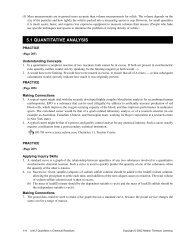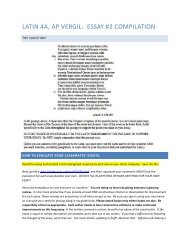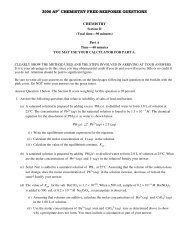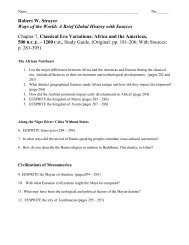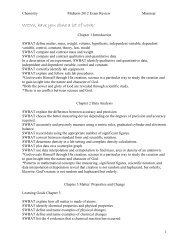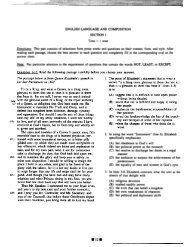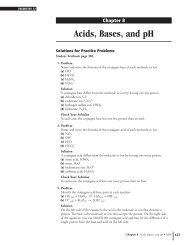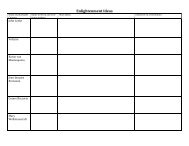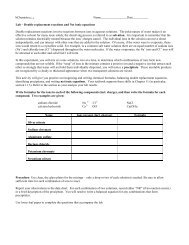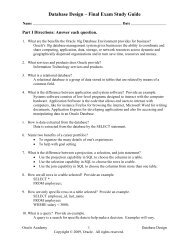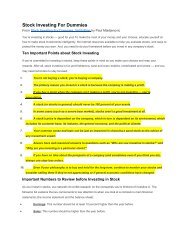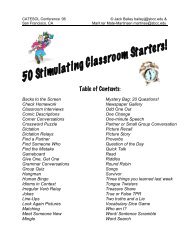Mouse Color Variation - Quia
Mouse Color Variation - Quia
Mouse Color Variation - Quia
You also want an ePaper? Increase the reach of your titles
YUMPU automatically turns print PDFs into web optimized ePapers that Google loves.
The Making of the Fittest:<br />
Natural Selection and Adaptation<br />
LESSON<br />
STUDENT HANDOUT<br />
COLOR VARIATION OVER TIME IN ROCK POCKET MOUSE POPULATIONS<br />
INTRODUCTION<br />
The tiny rock pocket mouse weighs just 15 grams, about as much as a handful of paperclips. A typical rock pocket mouse<br />
is just about 170 millimeters long from nose to rump, shorter than an average pencil. Their impact on science, however,<br />
has been enormous. What’s so special about these little mice?<br />
Populations of rock pocket mice are found all over the Sonoran Desert in the southwestern United States. There are two<br />
common varieties—a light-colored variety and a dark-colored variety. Similarly, there are two major colors of substrate,<br />
or surface materials, that make up the desert floor. Most of the landscape consists of light-colored sand and rock. Here<br />
and there, however, separated by several kilometers of light-colored substrate, are patches of dark volcanic rocks that<br />
formed from cooling lava flows.<br />
The illustrations that follow represent snapshots of rock pocket mouse populations. Each illustration shows the color<br />
variation at two different locations, A and B, at a particular moment in time over a period of several hundred years.<br />
Note: The images are out of order.<br />
MATERIALS<br />
You will need:<br />
• colored pencils<br />
PROCEDURE<br />
1. Count the number of light-colored and dark-colored mice present at each location at each moment in time. Record<br />
your counts in the spaces provided above each illustration.<br />
2. Place the illustrations in what you think is the correct order from oldest to most recent. Indicate your order by circling<br />
the appropriate number under the illustration.<br />
3. Explain how you decided which illustration represents the most recent rock pocket mouse population and why you<br />
positioned the others in the sequence as you did.<br />
____________________________________________________________________________________<br />
____________________________________________________________________________________<br />
____________________________________________________________________________________<br />
____________________________________________________________________________________<br />
____________________________________________________________________________________<br />
____________________________________________________________________________________<br />
____________________________________________________________________________________<br />
____________________________________________________________________________________<br />
____________________________________________________________________________________<br />
____________________________________________________________________________________<br />
Published March 2012<br />
www.BioInteractive.org Page 1 of 8
The Making of the Fittest:<br />
Natural Selection and Adaptation<br />
LESSON<br />
STUDENT HANDOUT<br />
Location A: number of mice with light-colored fur _____<br />
Location B: number of mice with light-colored fur _____<br />
number of mice with dark-colored fur _____<br />
number of mice with dark-colored fur _____<br />
When all four illustration pages are placed in order, this one is the<br />
1 st (oldest) 2 nd 3 rd 4 th (most recent)<br />
(Circle the appropriate number)<br />
www.BioInteractive.org Page 2 of 8
The Making of the Fittest:<br />
Natural Selection and Adaptation<br />
LESSON<br />
STUDENT HANDOUT<br />
Location A: number of mice with light-colored fur _____<br />
number of mice with dark-colored fur _____<br />
Location B: number of mice with light-colored fur _____ number of mice with dark-colored fur _____<br />
When all four illustration pages are placed in order, this one is the<br />
1 st (oldest) 2 nd 3 rd 4 th (most recent)<br />
(Circle the appropriate number)<br />
www.BioInteractive.org Page 3 of 8
The Making of the Fittest:<br />
Natural Selection and Adaptation<br />
LESSON<br />
STUDENT HANDOUT<br />
Location A: number of mice with light-colored fur _____<br />
Location B: number of mice with light-colored fur _____<br />
number of mice with dark-colored fur _____<br />
number of mice with dark-colored fur _____<br />
When all four illustration pages are placed in order, this one is the<br />
1 st (oldest) 2 nd 3 rd 4 th (most recent)<br />
(Circle the appropriate number)<br />
www.BioInteractive.org Page 4 of 8
The Making of the Fittest:<br />
Natural Selection and Adaptation<br />
LESSON<br />
STUDENT HANDOUT<br />
Location A: number of mice with light-colored fur _____<br />
Location B: number of mice with light-colored fur _____<br />
number of mice with dark-colored fur _____<br />
number of mice with dark-colored fur _____<br />
When all four illustration pages are placed in order, this one is the<br />
1 st (oldest) 2 nd 3 rd 4 th (most recent)<br />
(Circle the appropriate number)<br />
www.BioInteractive.org Page 5 of 8
The Making of the Fittest:<br />
Natural Selection and Adaptation<br />
LESSON<br />
STUDENT HANDOUT<br />
4. Watch the film The Making of the Fittest: Natural Selection and Adaptation. As you watch, look for an explanation for the<br />
differences among the illustrations that will help you to confirm that the order in which you arranged the illustrations is<br />
correct. Think about the following as you watch the film:<br />
• Why are some mice light-colored and some mice dark-colored?<br />
• Does fur color provide any selective advantage or disadvantage?<br />
• What role does the rock pocket mouse play in the desert food web?<br />
• What can explain the differences among the illustrations?<br />
5. Using what you learned by watching the film, check the order in which you arranged the illustrations. Change the<br />
numbers you circled under the illustrations as necessary. Once you are satisfied you are correct, fill out the data table<br />
using the counts you recorded above the illustrations.<br />
First<br />
(oldest)<br />
Second Third Fourth<br />
(most recent)<br />
Location<br />
A<br />
Number of<br />
mice with<br />
light fur<br />
Number of<br />
mice with<br />
dark fur<br />
Location<br />
B<br />
Number of<br />
mice with<br />
light fur<br />
Number of<br />
mice with<br />
dark fur<br />
www.BioInteractive.org Page 6 of 8
The Making of the Fittest:<br />
Natural Selection and Adaptation<br />
LESSON<br />
STUDENT HANDOUT<br />
6. Use colored pencils to prepare a bar graph based on the data that shows the distribution of the mice at locations A and<br />
B through time. Be sure to provide appropriate titles and labels for the x- and y-axes. You may record all of your data for<br />
each time period (A and B) on one bar graph or split A and B and make two graphs.<br />
www.BioInteractive.org Page 7 of 8
The Making of the Fittest:<br />
Natural Selection and Adaptation<br />
LESSON<br />
STUDENT HANDOUT<br />
QUESTIONS<br />
1. Explain why a rock pocket mouse’s color influences its overall fitness. Remember that “fitness” is defined by an<br />
organism’s ability to survive and produce offspring.<br />
____________________________________________________________________________________<br />
____________________________________________________________________________________<br />
____________________________________________________________________________________<br />
____________________________________________________________________________________<br />
2. Explain the presence of dark-colored mice at Location A. Why didn’t this phenotype become more common in the<br />
population?<br />
____________________________________________________________________________________<br />
____________________________________________________________________________________<br />
____________________________________________________________________________________<br />
3. Write a scientific summary that describes changes in the rock pocket mouse populations at Location B. Your summary<br />
should include:<br />
• a description of how the population has changed over time.<br />
• an explanation of what caused the changes.<br />
• a prediction that describes what the population will look like 100 years in the future. Your prediction should be based on<br />
trends in the data you have organized. You can assume that environmental conditions do not change over the 100 years.<br />
____________________________________________________________________________________<br />
____________________________________________________________________________________<br />
____________________________________________________________________________________<br />
____________________________________________________________________________________<br />
____________________________________________________________________________________<br />
____________________________________________________________________________________<br />
4. Use the data and what you’ve learned about evolution to explain how mutation is a random process, but natural<br />
selection is not random.<br />
____________________________________________________________________________________<br />
____________________________________________________________________________________<br />
AUTHOR<br />
Mary Colvard<br />
Cobleskill-Richmondville High School (retired)<br />
Deposit, New York<br />
www.BioInteractive.org Page 8 of 8




